Korean carrot salad isn’t just another side dish—it’s a crunchy, tangy, garlic-infused flavor bomb that took my kitchen (and my family) by storm. The first time I made it, I was just trying to use up a bunch of carrots from the garden. But somewhere between the sizzling garlic oil and the first zesty bite, it became clear: this recipe was going straight to the top of our weekly rotation.
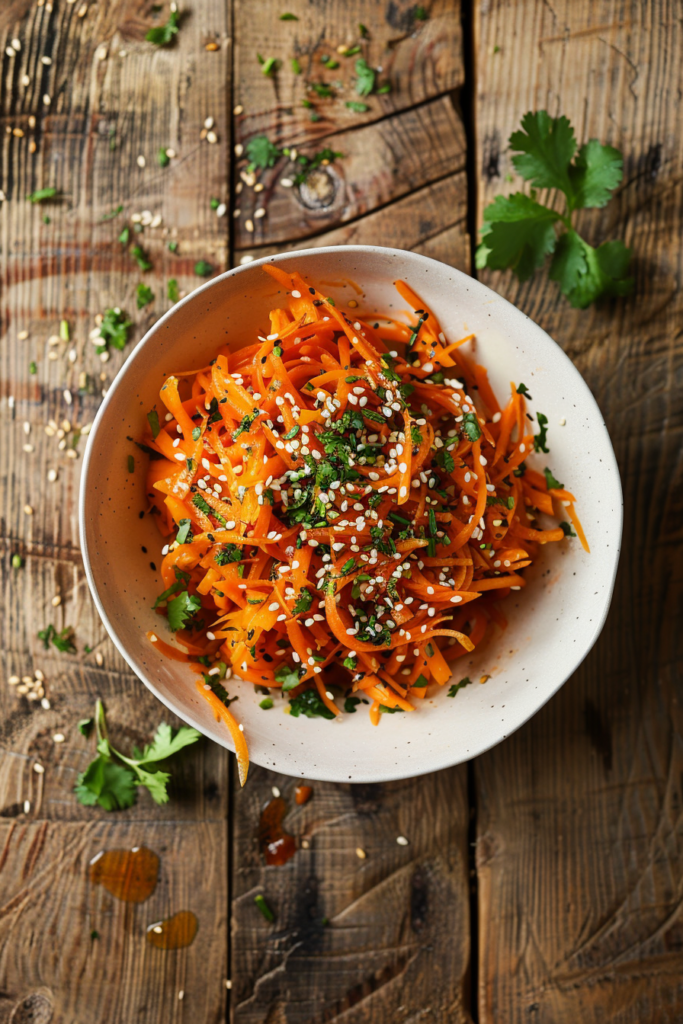
Now, you should know—around here at Grandy Recipes, I like to keep things simple and flavorful. I learned to cook by my mom’s side using garden veggies and pantry basics, and this korean carrot salad fits that philosophy to a tee. No fancy ingredients, no complicated prep. Just real food, real flavor, and recipes that bring people to the table.
What makes korean carrot salad so special? It’s bold without being overpowering. Sweet, salty, a little spicy, and completely addictive. It’s also known as Morkovcha, a dish created by Korean immigrants in Russia who missed their kimchi and made magic with carrots instead. Now it’s a beloved staple from Eastern Europe to home kitchens across America.
When I served it the first time, even Lola (our Beagle-slash-food-thief) couldn’t resist sniffing around the bowl. My kids had second helpings, and my husband claimed it tasted “like something from a really fancy fusion restaurant.” Honestly, I took that as a win.
So if you’re tired of bland side salads and need a quick dish that actually excites your taste buds, korean carrot salad is about to be your new obsession.
Be sure to check out our Carrot Ribbon Salad for another tasty way to use up those extra carrots
Table of Contents
Introduction to Korean Carrot Salad
How Korean Carrot Salad Won My Family Over
Before we dive into recipes, let’s get personal. Cooking has always been a family affair in our home, and korean carrot salad quickly turned from a curiosity to a fridge staple. It’s so quick to make—no oven, no blender, no fuss. Just crunchy carrots and a little patience while the flavors meld.
The first time I made it, Eliana helped me julienne the carrots (she’s got knife skills that would put a food processor to shame), while Daniel hovered nearby asking when he could try it. Even Alina, my oldest, who used to be a fast-food lover before switching to a high-protein lifestyle, declared this salad “actually addictive.” And no, I didn’t bribe her to say that.
Rooted in History, Spiced With Ingenuity
While it might be called korean carrot salad, its roots stretch from Korea to the kitchens of Soviet Central Asia. This dish was born out of necessity when ethnic Koreans (the Koryo-saram) relocated and could no longer access traditional ingredients like napa cabbage or radish. Carrots became the substitute, and boy, did they innovate.
Print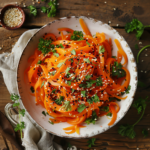
Korean Carrot Salad
- Total Time: 20 mins
Description
Morkovcha, also known as Korean carrot salad, is a flavorful and tangy dish made with crisp carrots. It’s simple to prepare using common pantry ingredients and makes an excellent side for any meal or picnic.
Ingredients
1 lb carrot
1 tsp kosher salt
1 1/2 tbsp sugar
2 tbsp white vinegar
1/2 tbsp Korean chili flakes (gochugaru), or 1/4 tsp cayenne pepper + 1 tsp paprika
3 tbsp oil
1 tbsp minced garlic
Instructions
- Peel the carrots and cut them into thin strips using a mandolin, vegetable slicer, or a sharp knife. Put the julienned carrots in a mixing bowl, sprinkle with salt, and let them sit for 10 minutes to wilt.
- Mix in the sugar, vinegar, and gochugaru (Korean chili flakes). If gochugaru is unavailable, use a combination of cayenne pepper and paprika. Toss everything together well.
- In a small pot, heat the oil over medium-low heat and sauté the garlic until it becomes aromatic, ensuring it doesn’t burn. Pour the hot garlic oil over the carrots and mix thoroughly.
- The salad can be served immediately or chilled in the fridge for 2 hours to enhance the flavors. For storage, this carrot salad can be kept in the refrigerator for up to 1 week.
Notes
- For the vinegar, regular rice vinegar or white vinegar are typical choices, but white wine vinegar is also a great option. Avoid dark vinegar like balsamic vinegar, as it will obscure the bright orange color of the carrots.
- For a milder salad, you can omit gochugaru or substitute it with a mix of cayenne pepper and paprika. For a more robust flavor, sprinkle a little bit of spices like coriander or cardamom.
- Prep Time: 5 mins
- Cook Time: 15 mins
- Cuisine: Korean
Nutrition
- Serving Size: 6
- Calories: 132 kcal
- Sugar: 7 g
- Sodium: 451 mg
- Carbohydrates: 11 g
- Fiber: 2 g
- Protein: 1 g
Morkovcha is more than a quirky carrot dish—it’s culinary resilience served with spice. The flavor base is deceptively simple: vinegar, garlic, a touch of sugar, and red pepper flakes or gochugaru. The hot garlic oil brings it all together, infusing the carrots with depth and that signature tangy bite.
So yes, korean carrot salad might have humble origins, but once you try it, you’ll understand why it’s traveled across continents and generations to land on your table today.
If you have extra carrots to use, try our delicious Carrot Raisin Salad —you won’t want to miss it
What Is Korean Carrot Salad (Morkovcha)?
Origins: When Kimchi Traveled to Russia
The story of korean carrot salad starts not in Korea, but far away—in the kitchens of Korean immigrants in the former Soviet Union. Known as Morkovcha (or Morkov po-koreyski), this dish was born out of adaptation. In the 1930s, many ethnic Koreans, called Koryo-saram, were relocated from the Russian Far East to Central Asia. Cut off from traditional ingredients like napa cabbage and Korean radish, they had to improvise.
So what did they do? They turned to carrots—cheap, available, and surprisingly versatile. The result was a new kind of kimchi-inspired dish: spicy, vinegary, garlicky, and incredibly refreshing. This unique fusion became what we now call korean carrot salad.
It wasn’t just survival—it was culinary creativity. By combining Korean techniques with local Soviet ingredients, Koryo-saram cooks created something truly iconic. Even today, you’ll find korean carrot salad in markets across Russia, Ukraine, Kazakhstan, and beyond, often sold by weight in giant tubs.
How Morkovcha Differs From Traditional Kimchi
So how is this different from the traditional Korean kimchi you might know? First, there’s no fermentation. While kimchi takes days (sometimes weeks) to develop its sour depth, korean carrot salad is ready in under an hour. It’s lightly pickled, not fermented.
Second, it uses hot garlic oil to “bloom” the flavors right into the carrots, giving it a sharp kick without needing fish sauce or fermentation starters. That makes it not just vegan-friendly, but also perfect for anyone looking for a quick, flavor-packed side dish.
Korean carrot salad may not be traditional kimchi—but it has a bold identity all its own, and once you try it, you’ll understand why it’s a staple in so many homes.
Why Korean Carrot Salad Is So Popular
Easy to Make, Easy to Love
There’s a reason korean carrot salad has remained a staple in households for decades—it’s delightfully simple. With just a handful of ingredients you likely already have—carrots, vinegar, garlic, oil, and a bit of spice—you can whip up a dish that tastes like it took hours. Whether you’re new to cooking or a seasoned home chef, this recipe offers big rewards with minimal effort.
Its popularity also comes from how adaptable it is. You can make a mild version for kids or spice it up with gochugaru for a kick. It’s quick to prep and even quicker to vanish once it hits the table. The flavor gets better as it sits, making it an ideal make-ahead dish for gatherings, potlucks, or easy lunches.
Plus, if you’re like me and often cook with what’s in the fridge, korean carrot salad is a reliable go-to when you need something fresh and flavorful without a grocery run.
Nutritional Value and Health Benefits
Beyond flavor, korean carrot salad brings serious health perks. Carrots are rich in beta-carotene, a potent antioxidant, and also provide a good source of vitamin K, dietary fiber, and potassium. Because the salad uses no dairy, mayonnaise, or heavy oils, it remains light but satisfying.
Unlike heavier side dishes, this one is low in calories and sugar, yet still provides bold flavor and crunch. It’s gluten-free, naturally vegan, and fits into low-carb or keto lifestyles with just a small tweak to the sugar content.
So whether you’re serving a holiday roast or packing a weekday lunch, korean carrot salad gives you that crisp, bright contrast that elevates the entire meal—without weighing you down.
Authentic Korean Carrot Salad Recipe
Ingredients You Need (and Easy Swaps)
Making an authentic korean carrot salad at home is easier than you might think. The ingredients are simple, and you probably already have most of them in your kitchen. Here’s what you’ll need:
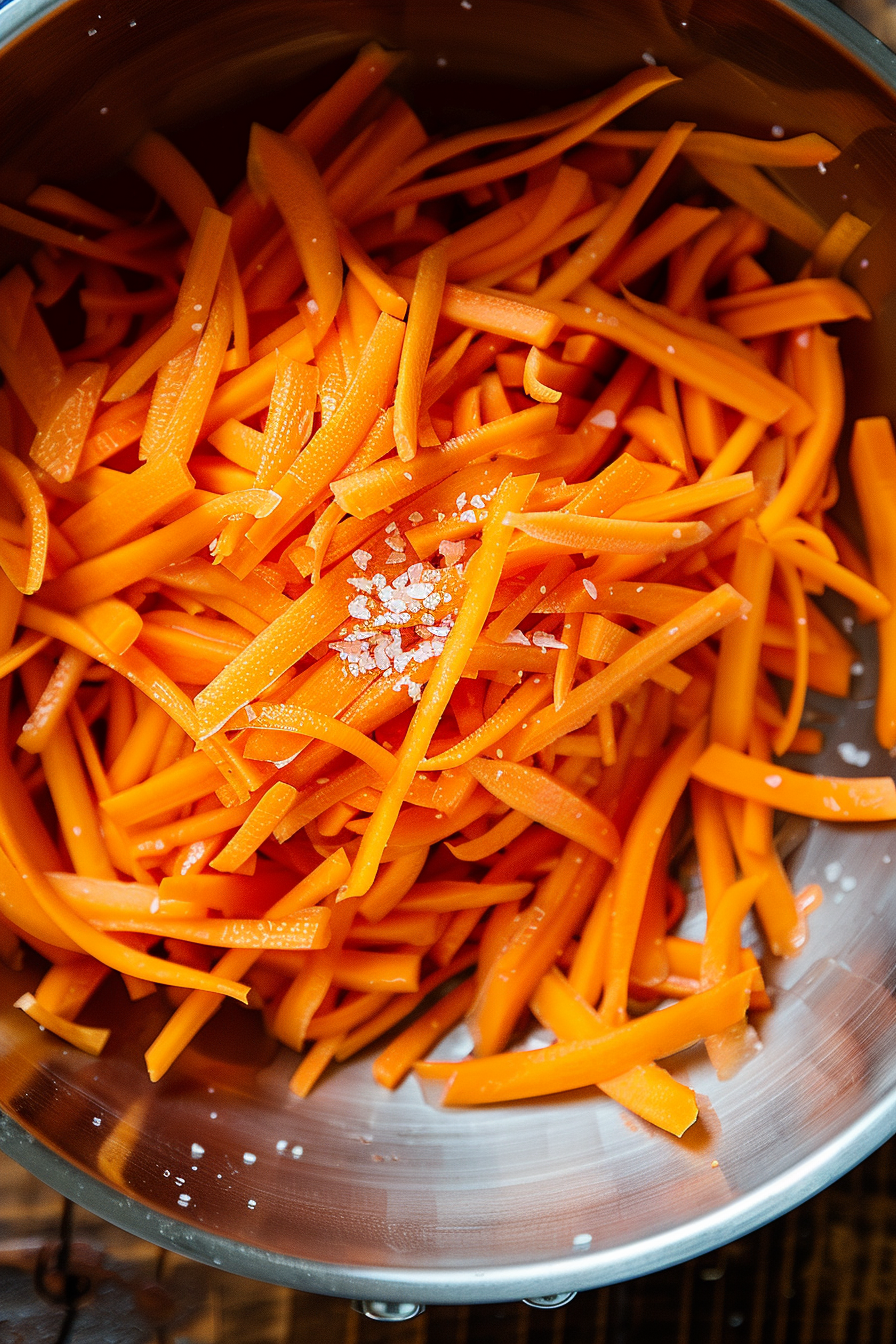
- 1 lb carrots, peeled and julienned
- 1 tsp salt
- 1 ½ tbsp sugar (can be reduced or swapped for a keto-friendly sweetener)
- 2 tbsp white vinegar (or rice vinegar for a milder flavor)
- ½ tbsp gochugaru (or use ¼ tsp cayenne + 1 tsp paprika for similar heat and color)
- 3 tbsp neutral oil (grapeseed, sunflower, or avocado oil work well)
- 1 tbsp minced garlic
Optional flavor boosters: a pinch of coriander, cardamom, or black pepper can add depth to the flavor. Avoid dark vinegars like balsamic—they’ll muddy the carrot’s vibrant color.
Step-by-Step Instructions (With Prep Tips)
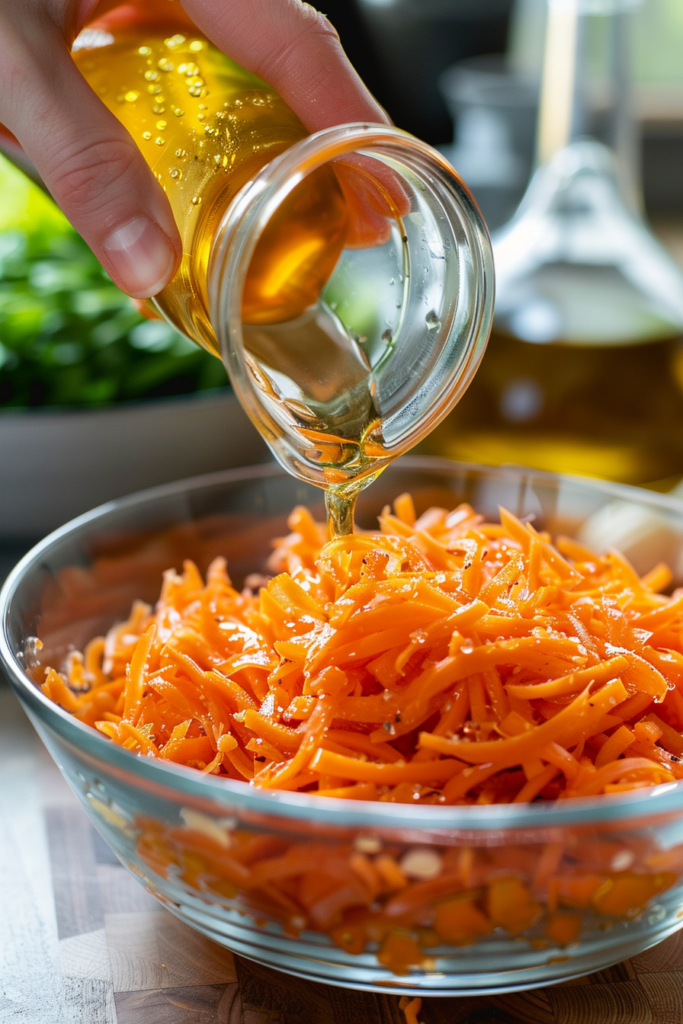
- Julienne the carrots using a mandolin slicer or sharp knife. Place them in a mixing bowl and sprinkle with salt. Let them sit for 10 minutes to soften slightly.
- Add the sugar, vinegar, and chili flakes. Toss well to combine.
- Heat the oil in a small pan over medium-low heat. Add minced garlic and cook just until fragrant—don’t burn it.
- Pour the hot garlic oil over the carrot mixture. Stir everything thoroughly until coated.
- Let the korean carrot salad rest for at least 30 minutes. For best flavor, refrigerate it for 2–4 hours before serving.
This korean carrot salad recipe is quick, customizable, and keeps well in the fridge. It’s one of those dishes that actually improves as it sits—perfect for meal prep or weekend gatherings.
How to Customize Korean Carrot Salad
Make It Milder, Spicier, or Low-Sugar
One of the best things about korean carrot salad is how customizable it is. Whether you’re cooking for spice lovers or picky eaters, there’s room to make it your own. Want a gentler kick? Swap out the gochugaru for just a pinch of paprika. If you’re going for more heat, use extra chili flakes or a few drops of Korean chili oil.
Watching your sugar intake? Replace the standard white sugar with erythritol or monk fruit sweetener. You’ll still get that signature tangy-sweet flavor without the carbs. And if you love acidity, increase the vinegar slightly to boost the brightness.
Another great tweak? Add a splash of sesame oil or a sprinkle of toasted sesame seeds for a nutty, earthy finish that works beautifully with the garlic.
Creative Twists: Add-Ins from Cabbage to Tofu Skins
Looking to take your korean carrot salad to the next level? Try adding thinly sliced cabbage, bean sprouts, or julienned bell peppers for extra crunch and color. Some traditional versions even include tofu skin strips—often called “Korean asparagus” in post-Soviet markets.
You can also toss in shredded daikon or a small handful of chopped fresh cilantro for an herbaceous twist. And if you want to turn it into a light meal, mix in cooked shredded chicken or tofu for added protein.
No matter how you spin it, korean carrot salad is endlessly versatile. Its core ingredients are neutral enough to welcome a range of flavors, making it a reliable favorite whether you’re building a picnic plate or sprucing up leftovers.
Best Ways to Serve Korean Carrot Salad
Pairing Suggestions: From BBQ to Bowls
One of the reasons korean carrot salad has such a loyal fan base is because it plays well with nearly everything. Need something bright and crunchy to balance a rich main course? This salad’s got you. It works as a crisp contrast to grilled meats like pork belly, steak, or chicken thighs, especially with BBQ flavors.
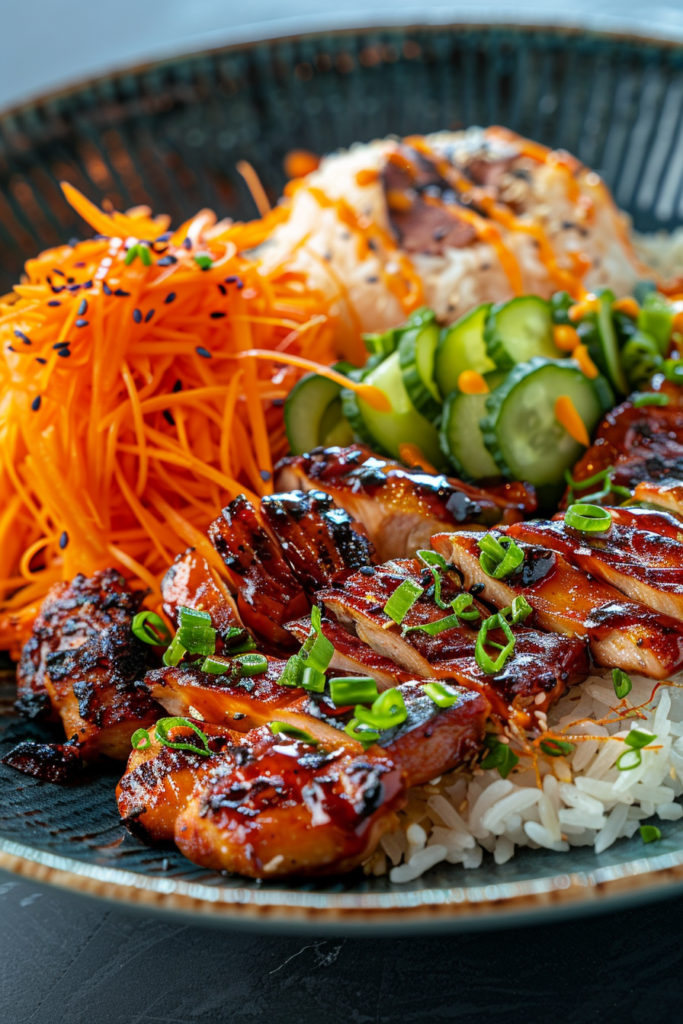
If you’re planning an Asian-inspired dinner, serve korean carrot salad alongside bibimbap, bulgogi, or spicy tofu stir-fry. The tangy carrots cut through heavy sauces and bring a fresh element to your plate. It also makes an excellent topping for rice bowls, noodles, or lettuce wraps.
Going international? It pairs well with Middle Eastern grilled dishes, Mediterranean platters, or even American burgers—yes, try it on a bun! Its acidity and crunch make it the perfect upgrade to the usual slaw.
How to Turn It Into a Full Meal
Although korean carrot salad shines as a side, it can also be transformed into a light main dish with a few simple additions. Toss in a protein source like shredded chicken, cooked lentils, or tofu cubes for a balanced and filling lunch.
Add a scoop of quinoa or cold soba noodles to create a vibrant grain bowl. Want it extra satisfying? Top with a soft-boiled egg and a drizzle of sesame dressing.
Even as a plant-based main, korean carrot salad holds its own thanks to its bold flavors and satisfying crunch. It’s a fast, fridge-friendly option for meal prep, and it travels well—ideal for picnics, office lunches, or summer road trips.
Find more delicious recipes on GrandyRecipes’ Pinterest, and stay inspired with the newest tips and ideas by following GrandyRecipes on Facebook.
Frequently Asked Questions (FAQs)
What is a Korean carrot salad called?
Korean carrot salad is traditionally called Morkovcha or Morkov po-koreyski—a dish created by ethnic Koreans living in Central Asia. Though not a native Korean recipe, it captures the spicy, tangy notes of Korean cuisine using simple ingredients.
Is Korean carrot salad good for you?
Definitely! Korean carrot salad is a great source of fiber, vitamin A, and antioxidants. It’s low in calories, gluten-free, and easily adaptable for keto or low-carb diets by swapping the sugar.
How long does it last?
When stored in an airtight container in the fridge, korean carrot salad stays fresh for up to 7 days. The flavors deepen over time, making it a great make-ahead dish. Avoid freezing, as it can ruin the crunchy texture.
Final Thoughts and Cooking Inspiration
Whether you’re making it for a quick lunch, a side dish, or a holiday potluck, korean carrot salad is one of those rare recipes that’s as practical as it is flavorful. It’s quick, easy, and endlessly customizable. Plus, it keeps well in the fridge—so there’s no rush to finish it in one sitting. If you’re craving something bright, crunchy, and full of zing, korean carrot salad should be your next kitchen go-to. From my family table to yours, may every bite be as satisfying as it is simple. Now, go grab those carrots!